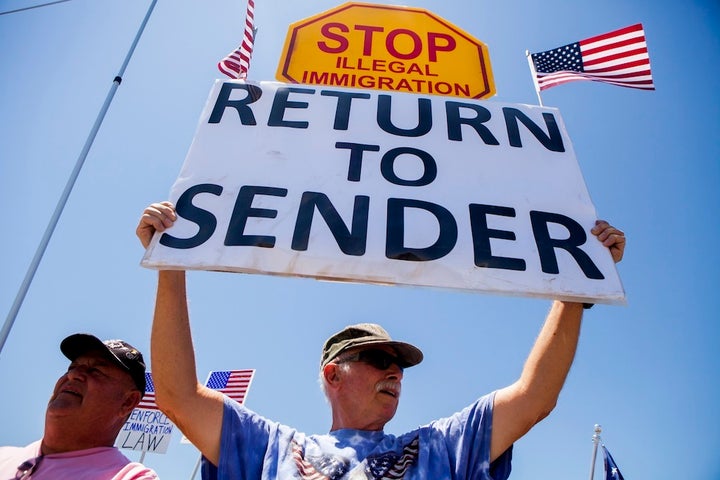
Anti-immigrant bigots protest detainees in Murrieta, Calif.
The anti-immigrants movement, the war on drugs and the war on terrorism have fueled the anti-Mexican and anti-Latino sentiment beyond measure. As reported by Law Professor David Cole, “racial profiling studies . . . make it clear that the war on drugs has largely been a war on minorities. It is, after all, drug enforcement that motivates most racial profiling.” Similarly, like the war on drugs, according to the American Civil Liberties Union, “the war on terror has quickly turned into a war on immigrants.” Broadly, contrary to the notion that laws are colorblind and thus ethnicity/race (combined with skin color) does not influence final outcomes, the ramifications of redefining race, ethnicity, crime, and punishment became gravely pressing in imprisonment rates (including immigration facilities for adults and children), as reported by University of California, Berkeley Professor Loïc Wacquant, “turning over from 70 percent white at the mid-century point to nearly 70 percent black and Latino today, although the ethnic patterns of criminal activity have not been fundamentally altered during that period.”
During the last two decades, with shifting demographic trends, possibly as in no other time in U.S. history is the dominant majority experiencing a more significant “cultural crisis” in that after centuries of total control in all facets of life their ideas about race, ethnicity, gender, immigration, citizenship, social life, and on other essential issues like representation and voting are under attack by the intertwining forces of diversity and multiculturalism as well as political and economic uncertainty, as recently documented by Martin Guevara Urbina in Twenty-First Century Dynamics of Multiculturalism: Beyond Post-Racial America. For instance, in the late twentieth century Harvard’s leading political scientist Samuel P. Huntington joined the anti-Mexican immigration propaganda by passionately commenting about the growing Latino population and therefore the inevitable “class of civilization,” charging that “While Muslims pose the immediate problem to Europe, Mexicans pose the problem for the United States.” Then, in the twenty-first century, Professor Huntington, who taught at Harvard University for more than a half-century, charged that the single and most immediate and most serious challenge to America’s traditional identity comes from the immense and continuing immigration from Latin America, especially from Mexico . . . transformation into two peoples with two cultures (Anglo and Hispanic) and two languages. . . a major potential threat to the country’s cultural and political integrity.
Tracing the historical roots of immigration laws, enforcement, and discourse, the immigration debate is more about culture than it is about legality—the fear of losing an historically cultivated white identity (the idea of a white nation) with its stablished domains of power, control, and dominance. Invariably, in part because the United States considers itself a ‘moral’ and ‘law-and-order’ society, the US has a phobia of the outsider, the different, and the stranger.
As an institutionalized state of feeling and thinking, such phobia has manifested itself into ignorance, which in turn has resulted in viciousness and vindictiveness . . . [and] fear of those who threaten our interests or the status quo has manifested itself into low levels of tolerance, making the criminal justice system, which includes immigration laws, enforcement, deportations, and incarceration, the prime apparatus for suppression, control, and silencing of those who threaten the dominant social structure—consequently, presenting a critical challenge for those who wish to reform the immigration system, the legal system, the criminal justice system as a whole, or simply join a criminal justice profession, like the judicial system, and once on the job, surviving an almost all-white environment, as until recently institutions have been composed mostly of white men. As a friend recently observed during a trip to a federal courthouse, “did you noticed? Everyone in the court was white, except the defendants [undocumented immigrants and others for drug charges] . . . and they call it a court of justice, porque no (why not) a court of injustice . . . there they are, looking at the defendants with disdain, yet that’s how they get their paycheck, wow, the system on payroll.”

Anti-immigration groups aren’t drawing large crowds to their rallies. | M.Scott Mahaskey/POLITICO
In all, the historical record reveals that while all legal and social actions over time warrant concern, as the United States strives for positive social transformation, it is the historically troubled immigration laws and enforcement that point to some of the deepest-rooted social problems in society—as immigration officers at the ports of entry and border patrol agents along the border are the frontline agents of immigration laws and thus the most visible upholders of national security, democracy, freedom, and public safety. Fundamentally, “At the heart of the American paradigm is the perception that law and its agents . . . are colorblind and thus justice is impartial, objective and seeks the truth. But, reality differs . . . decision makers are often more guided by their environment than by objectivity”, suggesting that the historical and contemporary dynamics of interacting forces, like conquest, colonialism, slavery, identity, and citizenship, continue to influence the everyday experience for undocumented people, legal residents, and U.S. citizens, and, in the area of law-and-order, how immigrants and other defendants are processed and treated by the immigration agents and the American police and subsequently the judicial and penal systems—including the thousands of immigrants process for deportation or incarceration.
The rapidly shifting immigration trends, diversity, multiculturalism, and demographics across the country in the twenty-first century, in the midst of globalization (including globalized migration), merits a newly energized research agenda to analyze immigration in its totality, delineating the simultaneous interaction of historical and contemporary forces driving immigration laws, enforcement, and discourse. For instance, while the immigration debate continues to revolve around Latino immigrants, particularly Mexican immigrants, Asians have already surpassed Latinos as the largest group of new immigrants to the United States, they are now the fastest-growing racial group in the U.S., and they are projected to surpass Latinos as the largest group of immigrants in the country by 2065 (Pew Research Center, 2013). Evidently, the time has come to explore the ways in which ethnicity and race shape immigration laws, enforcement practices, and discourse; ultimately, allowing us to gain sight into the future of America, along with the already largest immigrant group (Asians), the largest minority group (Latinos), and the largest ethnic minority group (Mexicans) in the United States, which, according to predictions, will soon constitute the two largest ethnic/racial groups in the country (Latinos and Asians)—the emerging new face of America and the upcoming majority.
Sofía Espinoza Álvarez is an author, researcher, legist, and advocate. She is a law graduate and holds a Bachelor of Science degree in criminal justice. Álvarez has maintained an active professional career and an intense research and publication agenda, publishing various academic book chapters, journal articles, and books. Her books include, Immigration and the Law: Race, Citizenship, and Social Control (forthcoming); Ethnicity and Criminal Justice in the Era of Mass Incarceration: A Critical Reader on the Latino Experience (2017); and Latino Police Officers in the United States: An Examination of Emerging Trends and Issues (2015).
